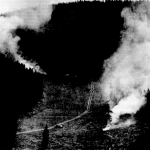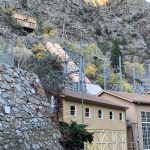Bennet, Neguse share speeches at Camp Hale on anniversary of national monument designation
10th Mountain Division veteran, tribal leaders speak on the importance of preserving legacy of sacred site

Chris Dillmann/Vail Daily
The one-year anniversary of Camp Hale’s designation as a national monument was celebrated Saturday with the unveiling of an interpretive sign declaring the designation, and an informational meeting for the public in Vail. Sen. Michael Bennet and U.S. Rep Joe Neguse shared words about the importance of the site, the process of the designation, and the potential future of Camp Hale.
The history of the land Camp Hale lies on, and the history of the former U.S. Army training site itself holds emotional weight for many who attended the events.
“Having spent so much time in Washington over the last couple of weeks, being back in Colorado, being at this elevation, and being here with all of you really is balm for the soul for me,” said Neguse, a Democrat who represents Colorado’s 2nd Congressional District, which includes most of Eagle County.
While the stunning landscape can be healing, the weight of its historical significance also was at the forefront of the minds of attendees.
“It’s hard not to look here, overlook the plains, and not be in awe of the sacrifices that were made by the young men who came here 80 years ago to serve our country, to make the ultimate sacrifice, during World War II,” Neguse said.

Support Local Journalism
A shared legacy

Manuel Heart, the chairman of the Ute Mountain Ute tribe, shared a blessing to open the ceremony at Camp Hale. Heart and Melvin Baker, chairman of the Southern Ute tribe, explained the connection of the Ute people to the land Camp Hale lies upon, and requested continued collaboration in the planning of the monument, with the opportunity to provide education on Ute history at Camp Hale.
“That is what this is all about, is to inform the next generation and the generation after that of all of the generations that have gone before us, not just the 10th Mountain veterans that were here, but their stories are important ones for us to furnish that story of Colorado’s legacy, of their legacy, but also important stewardship that the Ute people brought to this land long before the 10th Mountain Division was here,” Bennet said.
Heart asked for co-management and tribal involvement in protecting the public lands of Camp Hale.
“As we start to look at how we respect and honor these mountains, what’s here, let’s tell a good history about it,” Heart said.
Heart’s “good history” involves telling the story of the Ute people’s use of the Camp Hale land in addition to that of the 10th Mountain Division.
“We just ask respectfully, don’t forget us as the Ute people, as we, too, come from here, too. These lands were taken away at one time, but we are still a part of the citizenship of the state of Colorado,” Heart said.

“Historically, the area (of Camp Hale) was home to our Ute people,” Baker said. “As the monument land develops, it is important that our Ute history is included to educate visitors, welcome our relatives, and ensure that the contributions of the Ute people are not forgotten,” Baker said.
‘We’re just temporary renters’
Francis Lovett, a World War II veteran who trained in the 10th Mountain Division at Camp Hale for nearly three years, spoke adamantly about preserving what he called the “unique” heritage of the site.
“When all of us are gone, the very patient land will be here, and if we don’t blow the planet up with our technical wisdom, the land will wait. We think we own — no — it and the gorgeous woods own us. We’re just temporary renters who had better pay attention to the history,” Lovett said.
Lovett shared his vision for the cultivation of the Camp Hale monument site, including signage and carefully thought-out buildings that share the history of the 10th Mountain Division. “It must not become a tourist attraction, but it must be aimed to inform the public who may stop by and see how we lived,” he said.
Of any future construction done at Camp Hale, Lovett had one main request: “All I ask is that whatever is decided at the property called Camp Hale site, that you leave my pitons in the rock,” he said.
Make staying informed the easiest part of your day.
Sign up for daily or weekly newsletters at VailDaily.com/newsletter
The national monument designation provides the opportunity for the U.S. Forest Service to create a management plan for the public lands of Camp Hale and the Continental Divide. The forum in Vail also served as an opportunity for members of the public present to ask questions and weigh in on the plans for the future of the monument.
The process will be deliberately slow to allow for collaboration between all invested parties, including Colorado’s two Ute tribes, representatives of the 10th Mountain Division, state and local governments, and the general public.
“I think both chairmen said in their remarks that the reason to tell those stories is, in part, hoping that you don’t repeat the worst of the history that we have had, and that together we can build a brighter history, or a brighter future, than we might otherwise imagine,” Bennet said.
“We’re counting on this community, and communities across the Western Slope, in particular Eagle County, Summit County and Lake County, to be fully engaged in the process, as we know you all will, in ensuring that this national monument lives up to the legacy of the 10th Mountain Division,” Neguse said.










